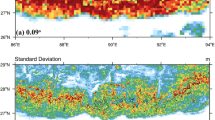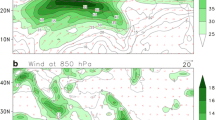Abstract
A P — σ regional climate model using a parameterization scheme to account for the thermal effects of the sub-grid scale orography was used to simulate the three heavy rainfall events that occurred within the Yangtze River Valley during the mei-yu period of 1991. The simulation results showed that by considering the sub-grid scale topography scheme, one can significantly improve the performance of the model for simulating the rainfall distribution and intensity during these three heavy rainfall events, most especially the second and third. It was also discovered that the rainfall was mainly due to convective precipitation. The comparison between experiments, either with and without the sub-grid scale topography scheme, showed that the model using the scheme reproduced the convergence intensity and distribution at the 850 hPa level and the ascending motion and moisture convergence center located at 500 hPa over the Yangtze River valley. However, some deviations still exist in the simulation of the atmospheric moisture content, the convergence distribution and the moisture transportation route, which mainly result in lower simulated precipitation levels. Further analysis of the simulation results demonstrated that the sub-grid topography scheme modified the distribution of the surface energy budget components, especially at the south and southwest edges of the Tibetan Plateau, leading to the development and eastward propagation of the negative geopotential height difference and positive temperature-lapse rate difference at 700 hPa, which possibly led to an improved precipitation simulation over eastern China.
Similar content being viewed by others
References
Ding, Y., 1993: Research on the 1991 Persistent, Severe Flood over Yangtze-Huai River Valley. China Meteorological Press, 255pp. (in Chinese)
Fu, B., 1983: Climate in Mountainous Regions. Science Press, Beijing, 270pp. (in Chinese)
Giorgi, F., 1997: An approach for the representation of surface heterogeneity in land surface models. Part I: Theoretical framework. Mon. Wea. Rev., 125, 1885–1899.
Giorgi, F., and R. Avissar, 1997: Representation of heterogeneity effects in earth system modeling: Experience from land surface modeling. Rev. Geophys., 35, 413–438.
Giorgi, F., R. Francisco, and J. Pal, 2003: Effects of a subgrid-scale topography and land use scheme on the simulation of surface climate and hydrology. Part I: Effects of temperature and water vapor disaggregation. J. Hydrometeor., 4, 317–333.
Ghan, S. J., X. Bian, A. G. Hunt, and A. Coleman, 2002: The thermodynamic influence of subgrid orography in a global climate model. Climate Dyn., 20, 31–44.
Kuo, H. L., and Y. Qian, 1981: Influence of the Tibetan Plateau on cumulative and diurnal changes of weather and climate in summer. Mon. Wea. Rev., 109, 2337–2356.
Kuo, H. L., and Y. Qian, 1982: Numerical simulation of the development of mean monsoon circulation in July. Mon. Wea. Rev., 110, 1879–1897.
Leung, L. R., and S. J. Ghan, 1998: Parameterizing sub-grid orographic precipitation and surface cover in climate models. Mon. Wea. Rev., 126, 3271–3291.
Li, L., and B. Zhu, 1990: The modified envelope orography and the air flow over and around mountains. Adv. Atmos. Sci., 7, 249–260.
Li, Z., and D. Weng, 1987: A model to compute the terrain parameters in mountainous region. Acta Geographica Sinica, 42(3), 269–274. (in Chinese)
Palmer, T. N., G. J. Shutts, and R. Swinbank, 1986: Alleviation of a systematic westerly bias in general circulation and numerical weather prediction models through an orographic gravity wave drag parameterization. Quart. J. Roy. Meteor. Soc., 112, 1001–1039.
Qian, Y., 1985: A five-layer primitive equation model with topography. Plateau Meteorology, 4(2), 1–28. (in Chinese)
Qian, Y., 1988: A scheme of calculation of heat balance temperature at ground surface. Scientia Atmospherica Sinica, 8, 14–27. (in Chinese)
Qian, Y., 2000: Effects of the envelope orography and gravity wave drag on the climate modeling. Quarterly Journal of Applied Meteorology, 11, 13–20. (in Chinese)
Qian, Y., and L. Dong, 1995: Effects of the envelope degree of orography on the simulated climate properties. Acta Meteorologica Sinica, 9, 302–312.
Seth, A., F. Giorgi, and R. E. Dickinson, 1994: Simulating fluxes from heterogeneous land surfaces: explicit sub-grid method employing the Biosphere-Atmosphere Transfer Scheme (BATS). J. Geophys. Res., 99, 18561–18667.
Wallace, J. M., S. Tibaldi, and A. J. Simmons, 1983: Reduction of systematic forecast errors in the ECMWF model through the introduction of an envelope orography. Quart. J. Roy. Meteor. Soc., 109, 683–718.
Wang, S., and Y. Qian, 2001: Effects of vertical resolution on the climate modeling in regional climate model. Plateau Meteorology, 20(1), 28–35. (in Chinese)
Wang, W.-C., W. Gong, and H. Wei, 2000: A regional model simulation of the 1991 severe precipitation event over the Yangtze-Huai River valley. Part I: Precipitation and circulation statistics. J. Climate, 13, 74–92.
Weng, D., W. Chen, J. Shen, and J. Gao, 1984: Agricultural Microclimate. China Agriculture Press, 99pp. (in Chinese)
Zhu, X., and Y. Zhang, 2005: Parameterization of subgrid topographic slope and orientation in numerical model and its effect on regional climate simulation. Plateau Meteorology, 24(2), 136–142. (in Chinese)
Zhang, Y., A. Huang, and X. Zhu, 2006: Parameterization of the thermal impacts of sub-grid orography on numerical modeling of the surface energy budget over East Asia. Theor. Appl. Climotol., 86, 201–214. DOI: 10.1007/s00704-005-0209-1.
Author information
Authors and Affiliations
Corresponding author
Rights and permissions
About this article
Cite this article
Feng, L., Zhang, Y. Impacts of the thermal effects of sub-grid orography on the heavy rainfall events along the Yangtze River Valley in 1991. Adv. Atmos. Sci. 24, 881–892 (2007). https://doi.org/10.1007/s00376-007-0881-4
Received:
Revised:
Issue Date:
DOI: https://doi.org/10.1007/s00376-007-0881-4




